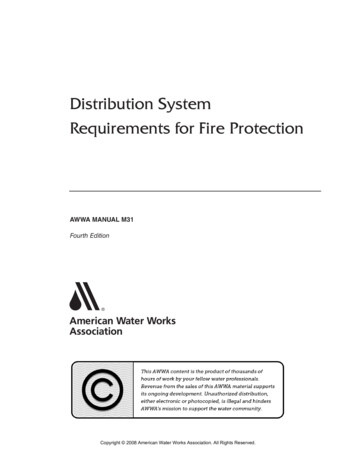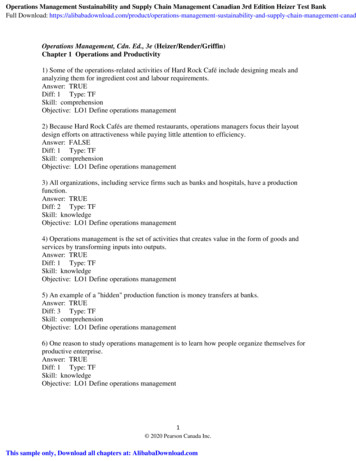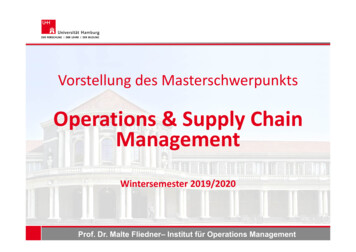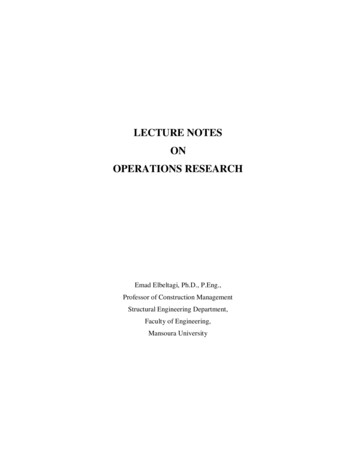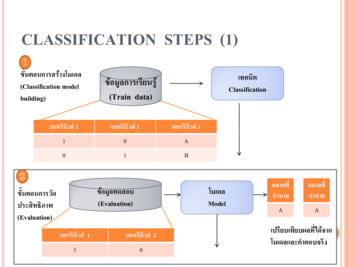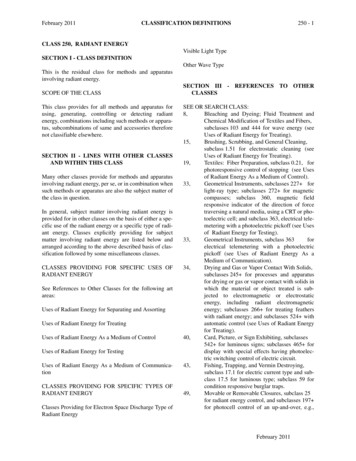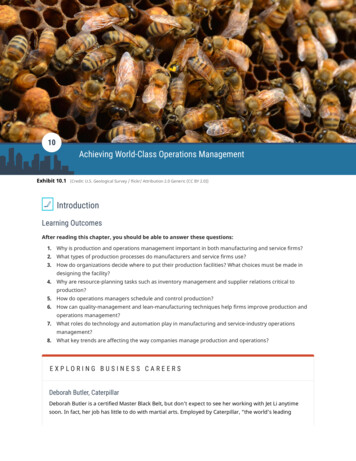
Transcription
10Achieving World-Class Operations ManagementExhibit 10.1(Credit: U.S. Geological Survey / flickr/ Attribution 2.0 Generic (CC BY 2.0))IntroductionLearning OutcomesAfter reading this chapter, you should be able to answer these questions:1. Why is production and operations management important in both manufacturing and service firms?2. What types of production processes do manufacturers and service firms use?3. How do organizations decide where to put their production facilities? What choices must be made indesigning the facility?4. Why are resource-planning tasks such as inventory management and supplier relations critical toproduction?5. How do operations managers schedule and control production?6. How can quality-management and lean-manufacturing techniques help firms improve production andoperations management?7. What roles do technology and automation play in manufacturing and service-industry operationsmanagement?8. What key trends are affecting the way companies manage production and operations?EXPLORING BUSINESS CAREERSDeborah Butler, CaterpillarDeborah Butler is a certified Master Black Belt, but don’t expect to see her working with Jet Li anytimesoon. In fact, her job has little to do with martial arts. Employed by Caterpillar, “the world’s leading
370Chapter 10 Achieving World-Class Operations Managementmanufacturer of construction and mining equipment, diesel and natural gas engines, and industrial gasturbines,” Butler’s Master Black Belt status reflects her expertise in Six Sigma, the process Caterpillaremployees use to continually manage, improve, and create processes, products, and services. “Sigma”refers to the maximum number of defects tolerated in production or service delivery; Six Sigma is thehighest level of quality control, demanding no more than 3.4 defects per million parts. That means if youwere to use Six Sigma in your college career, you would miss only one half of a single question in over fouryears of test-taking!Caterpillar was the first corporation to take Six Sigma global, deploying it corporate-wide in 2001 notonly to its almost 300 facilities, but also eventually to every dealer and more than 850 key suppliersthroughout the world. The corporation hails the process as a key element of its overall operationsmanagement, attributing increased profits, improved customer service, and supply-chain efficiency toSix Sigma.Caterpillar’s more than 300 Master Black Belts lead projects that use Six Sigma and train the company’sapproximately 3,300 Black Belts in the principles of the process. Butler is currently in charge of updatingand implementing Our Values in Action: Caterpillar’s Worldwide Code of Conduct. Outlining the four corevalues of integrity, excellence, teamwork, and commitment, the updated code of conduct embodies twoimportant aspects of Caterpillar’s philosophy on Six Sigma.Sigma is a Greek letter that represents a statistical unit of measurement and defines standard deviation.Caterpillar uses this standard deviation for the number of errors in a product, which equates to 3.4errors per million. Six Sigma is designed to reduce the number of errors in a process by a step-by-stepapproach. Caterpillar uses the Six Sigma methodology that utilizes the process of gathering information,analyzing the data, and then making decisions based on the facts. This process ensures that Caterpillaris meeting the requirements of the customer.Caterpillar recognizes that employees are the heart of any operation. Therefore, Caterpillar employeesuse Six Sigma to improve as people and as workers as much as to improve the products they produce.The core values, reflected in a series of action statements such as “We put Integrity in action when wecompete fairly,” are the product of a yearlong development process involving Butler’s global team. Aspart of the project research, the team interviewed thousands of Caterpillar employees, from officers ofthe company to production and hourly workers, for the purpose of, as Butler says, “bringing to thesurface the values that have made Caterpillar a successful enterprise, enhancing behavioralexpectations, and accurately expressing Caterpillar’s corporate culture.”Caterpillar is not content simply to produce Our Values in Action and leave it at that, however, and thesecond aspect of its Six Sigma philosophy is that employees must bring the process to their lives. Butlerhas worked to inject the code of conduct’s values into employees’ day-to-day work. If an employeewrites about safety-related changes, for example, she would not just list the changes. Instead, she mightwrite first: “According to Our Values In Action, we put Commitment in action when we protect the healthand safety of others and ourselves. As such, we are implementing the following changes. . . .” In thisway, the code becomes a living part of corporate culture, a critical component of operationsmanagement.Sources: Heather McBroom, “6 Sigma: Foundation for Quality at Caterpillar,” Peoria Magazine,http://www.peoriamagazines.com, accessed February 20, 2018; John Gillett, Ross Fink, and NickBevington, “How Caterpillar Uses 6 Sigma to Execute Strategy,” Strategic Finance Magazine,http://sfmagazine.com, accessed February 20, 2018; company website, “Christopher Six Sigma BlackThis OpenStax book is available for free at http://cnx.org/content/col25734/1.7
Chapter 10 Achieving World-Class Operations Management371Belt,” https://www.caterpillar.com, accessed February 20, 2018.Nearly every type of business organization needs to find the most efficient and effective methods of producingthe goods or services it sells to its customers. Technological advances, ongoing competition, and consumerexpectations force companies to rethink where, when, and how they will produce products or services.Manufacturers have discovered that it is no longer enough to simply push products through the factory andonto the market. Consumers demand high quality at reasonable prices. They also expect manufacturers todeliver products in a timely manner. Firms that can’t meet these expectations often face strong competitionfrom businesses that can. To compete, many manufacturers are streamlining how they make theirproducts—by automating their factories, developing new production processes, focusing on quality-controltechniques, and improving relationships with suppliers.Service organizations also face challenges. Their customers are demanding better service, shorter waitingperiods, and more individualized attention. Like manufacturers, service companies are using new methods todeliver what their customers need and want. Banks, for example, are using technology such as online bankingand mobile apps to make their services more accessible to customers. Colleges offer online courses toaccommodate the schedules of working students. Tax services file tax returns via the cloud.This chapter examines how manufacturers and service firms manage and control the creation of products andservices. We’ll discuss production planning, including the choices firms must make concerning the type ofproduction process they will use; the location where production will occur; the design of the facility; and themanagement of resources needed in production. Next, we’ll explain routing and scheduling, two critical tasksfor controlling production and operations efficiency. Then we will look at how firms can improve productionand operations by employing quality management and lean-manufacturing techniques. Finally, we will reviewsome of the trends affecting production and operations management.10.1Production and Operations Management—An Overview1. Why is production and operations management important in both manufacturing and service firms?Production, the creation of products and services, is an essential function in every firm. Production turnsinputs, such as natural resources, raw materials, human resources, and capital, into outputs, which areproducts and services. This process is shown in Exhibit 10.3. Managing this conversion process is the role ofoperations management.
372Exhibit 10.2Chapter 10 Achieving World-Class Operations ManagementWith new oil reserves now available through “fracking,” the United States is challenging Saudi Arabia and is set to become a vastsupplier of oil worldwide. Unlike the smooth petroleum that gushes from Arabian wells, however, America’s black gold in the Marcellus, Bakken,and other shale regions has to be drilled horizontally through new technology. The process is rigorous: oil and gas companies drill into theground to extract crude oil and natural gas from the shale rock that lies thousands of feet under the ground. Once the formation is reached,gallons of water, sand, and an extensive list of man-made chemicals are injected into the well under high pressure. This combination inserted inthe well will fracture the rock and release crude oil and natural gas. It is estimated that the gas within these rock formations could supply theUnited States for generations to come as technologies evolve to drill below the earth’s surface. What are key inputs in the fracking process?(Credit: Mark Dixon/ Flickr/ Attribution 2.0 Generic (CC BY 2.0))The goal of customer satisfaction is an important part of effective production and operations. In the past, themanufacturing function in most companies was inwardly focused. Manufacturing had little contact withcustomers and didn’t always understand their needs and desires. In the 1980s, many U.S. industries, such asautomotive, steel, and electronics, lost customers to foreign competitors because their production systemscould not provide the quality customers demanded. As a result, today most American companies, both largeand small, consider a focus on quality to be a central component of effective operations management.This OpenStax book is available for free at http://cnx.org/content/col25734/1.7
Chapter 10 Achieving World-Class Operations ManagementExhibit 10.3373Production Process for Products and Services (Attribution: Copyright Rice University, OpenStax, under CC BY 4.0 license.)Stronger links between marketing and manufacturing also encourage production managers to be moreoutwardly focused and to consider decisions in light of their effect on customer satisfaction. Servicecompanies find that making operating decisions with customer satisfaction in mind can be a competitiveadvantage.Operations managers, the people charged with managing and supervising the conversion process, play a vitalrole in today’s firm. They control about three-fourths of a firm’s assets, including inventories, wages, andbenefits. They also work closely with other major divisions of the firm, such as marketing, finance, accounting,and human resources, to ensure that the firm produces its goods profitably and satisfies its customers.Marketing personnel help them decide which products to make or which services to offer. Accounting andhuman resources help them face the challenge of combining people and resources to produce high-qualitygoods on time and at reasonable cost. They are involved in the development and design of goods anddetermine what production processes will be most effective.Production and operations management involve three main types of decisions, typically made at threedifferent stages:1. Production planning. The first decisions facing operations managers come at the planning stage. At thisstage, managers decide where, when, and how production will occur. They determine site locations andobtain the necessary resources.2. Production control. At this stage, the decision-making process focuses on controlling quality and costs,scheduling, and the actual day-to-day operations of running a factory or service facility.3. Improving production and operations. The final stage of operations management focuses on developingmore efficient methods of producing the firm’s goods or services.All three decisions are ongoing and may occur simultaneously. In the following sections, we will take a closerlook at the decisions and considerations firms face in each stage of production and operations management.Gearing Up: Production PlanningAn important part of operations management is production planning. Production planning allows the firm toconsider the competitive environment and its own strategic goals to find the best production methods. Good
374Chapter 10 Achieving World-Class Operations Managementproduction planning has to balance goals that may conflict, such as providing high-quality service whilekeeping operating costs low, or keeping profits high while maintaining adequate inventories of finishedproducts. Sometimes accomplishing all these goals is difficult.Exhibit 10.4From its storied creation in post-war Italy to its big-screen immortalization in movies such as Roman Holiday and Quadrophenia,the Vespa scooter has a reputation for romance, rebellion, and style. Manufactured by Italy’s Piaggio Group, the Vespa’s svelte, stainless-steelchassis and aeronautic-inspired designs are seen everywhere in Europe and more and more in the United States. The Piaggio Group presentlyoperates factories in Italy, Vietnam, India, and China. What important production-planning decisions does Piaggio need to make as it considersexpanding into more overseas markets? (Credit: Steve Watkins/ Flickr/ Attribution-2.0 Generic (CC BY2.0))Production planning involves three phases. Long-term planning has a time frame of three to five years. Itfocuses on which goods to produce, how many to produce, and where they should be produced. Medium-termplanning decisions cover about two years. They concern the layout of factory or service facilities, where andhow to obtain the resources needed for production, and labor issues. Short-term planning, within a one-yeartime frame, converts these broader goals into specific production plans and materials management strategies.Four important decisions must be made in production planning. They involve the type of production processthat will be used, site selection, facility layout, and resource planning.This OpenStax book is available for free at http://cnx.org/content/col25734/1.7
Chapter 10 Achieving World-Class Operations Management375CONCEPT CHECK1. What are the three types of decisions that must be made in production planning?2. What are the three phases of production planning?10.2The Production Process: How Do We Make It?2. What types of production processes do manufacturers and service firms use?In production planning, the first decision involves which type of production process—the way a good orservice is created—best fits with company goals and customer demand. An important consideration is the typeof good or service being produced, because different goods may require different production processes. Ingeneral, there are three types of production: mass production, mass customization, and customization. Inaddition to production type, operations managers also classify production processes in two ways: (1) howinputs are converted into outputs and (2) the timing of the process.One for All: Mass ProductionMass production, manufacturing many identical goods at once, was a product of the Industrial Revolution.Henry Ford’s Model-T automobile is a good example of early mass production. Each car turned out by Ford’sfactory was identical, right down to its color. If you wanted a car in any color except black, you were out ofluck. Canned goods, over-the-counter drugs, and household appliances are other examples of goods that aremass-produced. The emphasis in mass production is on keeping manufacturing costs low by producinguniform products using repetitive and standardized processes. As products became more complicated toproduce, mass production also became more complex. Automobile manufacturers, for example, must nowincorporate more sophisticated electronics into their car designs. As a result, the number of assembly stationsin most automobile manufacturing plants has increased.Just for You: Customizing GoodsIn mass customization, goods are produced using mass-production techniques, but only up to a point. At thatpoint, the product or service is custom-tailored to the needs or desires of individual customers. For example,American Leather, a Dallas-based furniture manufacturer, uses mass customization to produce couches andchairs to customer specifications within 30 days. The basic frames in the furniture are the same, butautomated cutting machinery precuts the color and type of leather ordered by each customer. Using massproduction techniques, they are then added to each frame.Customization is the opposite of mass production. In customization, the firm produces goods or services oneat a time according to the specific needs or wants of individual customers. Unlike mass customization, eachproduct or service produced is unique. For example, a print shop may handle a variety of projects, includingnewsletters, brochures, stationery, and reports. Each print job varies in quantity, type of printing process,binding, color of ink, and type of paper. A manufacturing firm that produces goods in response to customer
376Chapter 10 Achieving World-Class Operations Managementorders is called a job shop.Exhibit 10.5Classification of Production Types (Attribution: Copyright Rice University, OpenStax, under CC BY 4.0 license.)Mass ProductionMass CustomizationCustomizationHighly uniform productsUniform standardized productionEach product or serviceor servicesto a point, then unique featuresproduced according toMany products madeadded to each productindividual customerrequirementssequentiallyExamples: BreakfastExamples: Dell Computers, tractExamples: Custom homes,cereals, soft drinks, andhomes, and Taylor Made golf clubslegal services, and haircutscomputer keyboardsSome types of service businesses also deliver customized services. Doctors, for instance, must consider theillnesses and circumstances of each individual patient before developing a customized treatment plan. Realestate agents may develop a customized service plan for each customer based on the type of house theperson is selling or wants to buy. The differences between mass production, mass customization, andcustomization are summarized in Exhibit 10.5.Converting Inputs to OutputsAs previously stated, production involves converting inputs (natural resources, raw materials, humanresources, capital) into outputs (products or services). In a manufacturing company, the inputs, the productionprocess, and the final outputs are usually obvious. Harley-Davidson, for instance, converts steel, rubber, paint,and other inputs into motorcycles. But the production process in a service company involves a less obviousconversion. For example, a hospital converts the knowledge and skills of its medical personnel, along withequipment and supplies from a variety of sources, into health care services for patients. Table 10.1 providesexamples of the inputs and outputs used by various other businesses.There are two basic processes for converting inputs into outputs. In process manufacturing, the basic inputs(natural resources, raw materials) are broken down into one or more outputs (products). For instance, bauxite(the input) is processed to extract aluminum (the output). The assembly process is just the opposite. Thebasic inputs, like natural resources, raw materials, or human resources, are either combined to create theoutput or transformed into the output. An airplane, for example, is created by assembling thousands of parts,which are its raw material inputs. Steel manufacturers use heat to transform iron and other materials intosteel. In services, customers may play a role in the transformation process. For example, a tax preparationThis OpenStax book is available for free at http://cnx.org/content/col25734/1.7
Chapter 10 Achieving World-Class Operations Management377service combines the knowledge of the tax preparer with the client’s information about personal finances inorder to complete the tax return.Production TimingA second consideration in choosing a production process is timing. A continuous process uses longproduction runs that may last days, weeks, or months without equipment shutdowns. This is best for highvolume, low-variety products with standardized parts, such as nails, glass, and paper. Some services also use acontinuous process. Your local electric company is an example. Per-unit costs are low, and production is easyto schedule.Converting Inputs to OutputsType ofInputOutputOrganizationAirlineGrocery storeHigh schoolManufacturerPilots, flight attendants, reservations system, ticketingMovement ofagents, customers, airplanes, maintenance crews,customers andground facilitiesfreightMerchandise, building, clerks, supervisors, storeGroceries forfixtures, shopping carts, customerscustomersFaculty, curriculum, buildings, classrooms, library,Graduates, publicauditorium, gymnasium, students, staff, suppliesserviceMachinery, raw materials, plant, workers, managersFinished products forconsumers and otherfirmsRestaurantFood, cooking equipment, servers, chefs, dishwashers,Meals for patronshost, patrons, furniture, fixturesTable 10.1In an intermittent process, short production runs are used to make batches of different products. Machinesare shut down to change them to make different products at different times. This process is best for lowvolume, high-variety products such as those produced by mass customization or customization. Job shops areexamples of firms using an intermittent process.Although some service companies use continuous processes, most service firms rely on intermittentprocesses. For instance, a restaurant preparing gourmet meals, a physician performing surgical procedures,and an advertising agency developing ad campaigns for business clients all customize their services to suiteach customer. They use the intermittent process. Note that their “production runs” may be very short—onegrilled salmon or one physical exam at a time.
378Chapter 10 Achieving World-Class Operations ManagementCONCEPT CHECK1. Describe the different types of production processes.2. How are inputs transformed into outputs in a variety of industries?10.3Location, Location, Location: Where Do We Make It?3. How do organizations decide where to put their production facilities? What choices must be made indesigning the facility?A big decision that managers must make early in production and operations planning is where to put thefacility, be it a factory or a service office. The facility’s location affects operating and shipping costs and,ultimately, the price of the product or service and the company’s ability to compete. Mistakes made at thisstage can be expensive, because moving a factory or service facility once production begins is difficult andcostly. Firms must weigh a number of factors to make the right decision.Exhibit 10.6Facing stiff competition from rival automobile companies and sagging demand among German consumers, Germany’s BMW(Bavarian Motor Works) opened a factory in Spartansburg, South Carolina. Opened in 1994, the U.S. plant recently produced it four millionthvehicle and now employs 9,000 employees in its six million square foot plant. What factors determine where auto companies locate theiroperations? (Credit: Daniel Chou/ Flickr/ Attribution-NoDerivs 2.0 Generic (CC BY-ND 2.0))Availability of Production InputsAs we discussed earlier, organizations need certain resources to produce products and services for sale.This OpenStax book is available for free at http://cnx.org/content/col25734/1.7
Chapter 10 Achieving World-Class Operations Management379Access to these resources, or inputs, is a huge consideration in site selection. Executives must assess theavailability of raw materials, parts, equipment, and available manpower for each site under consideration. Thecost of shipping raw materials and finished goods can be as much as 25 percent of a manufacturer’s total cost,so locating a factory where these and other costs are as low as possible can make a major contribution to afirm’s success.Companies that use heavy or bulky raw materials, for example, may choose to be located close to theirsuppliers. Mining companies want to be near ore deposits, oil refiners near oil fields, paper mills near forests,and food processors near farms. Bottlers are discovering that rural western communities in need of aneconomic boost make rich water sources. In Los Lunas, New Mexico, it made sense for Niagara PurifiedDrinking Water to produce purified bottled water in a 166,000 square foot building that was vacant. Thebusiness helps diversify the town’s economy and created 40 new, much-needed jobs.1The availability and cost of labor are also critical to both manufacturing and service businesses, and theunionization of local labor is another point to consider in many industries. Payroll costs can vary widely fromone location to another due to differences in the cost of living; the number of jobs available; and the size,skills, and productivity of the local workforce. In the case of the water-bottling company, a ready pool ofrelatively inexpensive labor was available due to high unemployment in the areas.Marketing FactorsBusinesses must evaluate how their facility location will affect their ability to serve their customers. For somefirms it may not be necessary to be located near customers. Instead, the firm will need to assess the difficultyand costs of distributing its goods to customers from its chosen location. Other firms may find that locatingnear customers can provide marketing advantages. When a factory or service center is close to customers, thefirm can often offer better service at a lower cost. Other firms may gain a competitive advantage by locatingtheir facilities so that customers can easily buy their products or services. The location of competitors may alsobe a consideration. And businesses with more than one facility may need to consider how far to spread theirlocations in order to maximize market coverage.Manufacturing EnvironmentAnother factor to consider is the manufacturing environment in a potential location. Some localities have astrong existing manufacturing base. When a large number of manufacturers in a certain industry are alreadylocated in an area, that area is likely to offer greater availability of resources, such as manufacturing workers,better accessibility to suppliers and transportation, and other factors that can increase a plant’s operatingefficiency.Nestlé is proposing to open a new bottled water plant in the desert city of Phoenix. The plants have providedmuch-needed employment to replace jobs lost in the recession of 2008. The city of Phoenix faced opposition tothe plant because some locals thought that diverting water from tap water to a for-profit entity was not asound idea. Phoenix officials contend that the source of water is adequate for decades to come.2Local IncentivesIncentives offered by countries, states, or cities may also influence site selection. Tax breaks are a commonincentive. A locality may reduce the amount of taxes a firm must pay on income, real estate, utilities, or payroll.Local governments may offer financial assistance and/or exemptions from certain regulations to attract or
380Chapter 10 Achieving World-Class Operations Managementkeep production facilities in their area. For example, many U.S. cities are competing to attract a secondAmazon headquarters and, in addition to touting local attractions and a strong workforce, most of them areoffering a host of tax incentives.3International Location ConsiderationsThere are often sound financial reasons for considering a foreign location. Labor costs are considerably lowerin countries such as Singapore, China, India, and Mexico. Foreign countries may also have fewer regulationsgoverning how factories operate. A foreign location may also move production closer to new markets.Automobile manufacturers such as Toyota, BMW, and Hyundai are among many that build plants in the UnitedStates to reduce shipping costs.Designing the FacilityAfter the site location decision has been made, the next focus in production planning is the facility’s layout.The goal is to determine the most efficient and effective design for the particular production process. Amanufacturer might opt for a U-shaped production line, for example, rather than a long, straight one, to allowproducts and workers to move more quickly from one area to another.Service organizations must also consider layout, but they are more concerned with how it affects customerbehavior. It may be more convenient for a hospital to place its freight elevators in the center of the building,for example, but doing so may block the flow of patients, visitors, and medical personnel between floors anddepartments.There are three main types of facility layouts: process, product, and fixed-position. All three layouts areillustrated in Exhibit 10.7. Cellular manufacturing is another type of facility layout.This OpenStax book is available for free at http://cnx.org/content/col25734/1.7
Chapter 10 Achieving World-Class Operations ManagementExhibit 10.7Types of Facility Layouts Source: Adapted from Operations Management, 9th edition, by Gaither/Frazier.381
382Chapter 10 Achieving World-Class Operations ManagementProcess Layout: All Welders Stand HereThe process layout arranges workflow around the production process. All workers performing similar tasksare grouped together. Products pass from one workstation to another (but not necessarily to everyworkstation). For example, all grinding would be done in one area, all assembling in another, and allinspection in yet another. The process layout is best for firms that produce small numbers of a wide variety ofproducts, typically using general-purpose machines that can be changed rapidly to new operations fordifferent product designs. For example, a manufacturer of custom machinery would use a p
Why are resource-planning tasks such as inventory management and supplier relations critical to . scheduling, and the actual day-to-day operations of running a factory or service facility. . look at the decisions and considerations firms face in each stage of production and operations management

